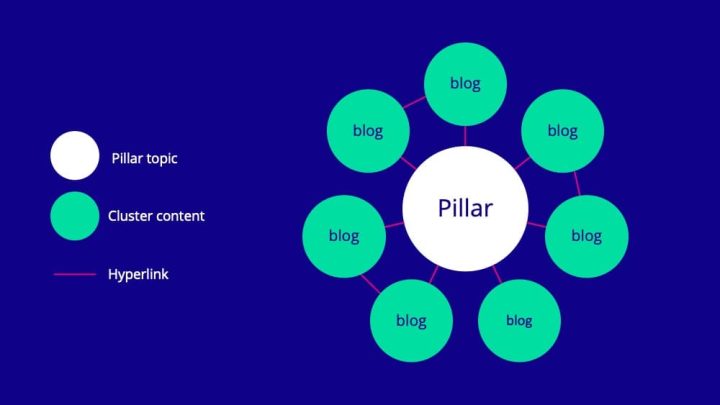5 steps to implement a pillar content strategy
Content marketing is a key component of any successful digital marketing strategy. But creating engaging and effective content is not that easy. With so much noise online, it can be a tough challenge to cut through the clutter and get your audience’s attention. This is where a pillar content strategy comes in. By implementing a pillar content strategy, organizations can overcome their challenges in content marketing and create a foundation for content marketing success.
In this article, we’ll dive into the challenges of content marketing and how a pillar content strategy can help you overcome these. Whether you’re a small business owner or part of a larger marketing team, this article provides you with the tools and insights you need to create a successful pillar content strategy.
What is a pillar content strategy?
A pillar content strategy is a focused approach to content marketing that involves creating a core set of themes central to a business, and then developing in-depth pieces of content around these themes. This approach serves as the foundation for the rest of your content marketing efforts, providing a clear and consistent message for engaging with your audience. By establishing a pillar content strategy, your business can build trust with your audience, increase online visibility, and achieve your marketing goals. A pillar content strategy can also provide you with a roadmap for future content creation and help your team stay focused and on track with their content marketing efforts.

1 - Understand your audience
You just can’t create a decent content strategy if you don’t know your target audience well enough. Getting to know them well enough should be on the top of your priority list.
Buyer persona
When defining your buyer persona, you need to think about all kinds of things, like what channels people use and what challenges they have that you can help them tackle. You also take into account some demographic information that can be useful. These pieces of information will tell you something about your persona’s search intent.
Keyword research
You’ll also need to do some keyword research based on your buyer persona’s. This will help you understand better what your audience is looking for and what keywords they use when searching online. You’ll likely find a whole bunch of keywords, and that’s OK. Just copy everything into an excel file, including other columns like search volume. By analyzing, sorting and grouping data, you’ll eventually understand what topics your persona’s would be looking for. This research will also serve as a good base for your search engine optimization when you are optimizing your website, so this really is an important step in the whole process.
2 - Choose your pillar topics
Once you have done a thorough keyword research, you should be able to identify a list of topics. Now it’s time to take a closer look at the topics and their respective keywords, and match that with your organization’s areas of expertise. To really match this to the topics, you need to look past the features of your products and really focus on the added value for your ideal customer.
Once you have all of this, you can start aligning the different topics with your target audience’s needs and the strengths your company has. The trick is to define your topics in such a way that they resonate well with your target audience as well as your company’s expertise. This helps establish your business as a trusted source of information and helps you build strong relationships. When you align your pillar topics with both your audience’s needs and your company’s strengths, you create content that is both valuable to your audience and showcases your expertise. This will help you drive conversions and achieve your marketing goals.
Expert tip: Don’t select too many pillar topics. Instead choose a few really good ones that you can really focus on and create some good content for in the sort term. Too many topics means you can’t focus.
3 - Quality content for each pillar
Now it’s time for content creation. First you’ll need to decide what content formats you need for every pillar. Whether it’s a blog article, a video or an infographic, every piece of content needs to be well-researched, visually appealing to your target audience and well written. By investing the necessary time and effort into content creation, you’ll end up with good content that helps you establish your organization as a trusted source of information. Your target audience will be more likely to find you online and engage with your organization. Focusing on quality content for every pillar is key for the success of your pillar content strategy and ultimately for achieving your marketing goals.
After writing your content, you’ll still need to optimize for search engines. After all, part of the reason you are doing content marketing in the first place is to attract people. It makes total sense. Remember your keyword research? Now is the time to use those in your page titles, meta descriptions and header tags. And don’t forget the alt text for your images. All of this helps you improve your content’s visibility in search results and makes it more likely to be found by your ideal customers.
However, don’t over-optimize. What we mean by that, while search engines are important, they are not the reason you are creating content. Your audience, a group of human beings, is the reason.
4 - Update existing content
You also need to take a closer look at your existing content. Does it fit in your new pillar content approach? Does it answer the questions your buyer persona has? Is it aligned with your audience’s needs and your company’s strengths? Most probably you’ll need to update some content.
Some content will not fit your new pillar topics at all. You can just throw that out. Judging what goes or stays is not always very straightforward. It’s up to you to decide where to draw the line. In any case, some content will be easy to update so it fits nicely in your pillar strategy. It might only take a few tweaks in terms of titles or keywords. Perhaps for some content you’ll need to rewrite or delete sections, and that’s fine too.
Expert tip: whatever the updates may be, you should use the keyword research and your pillar topics as your north star when evaluating whether or not the quality of your content is good enough.
5 - Interlink pillar and cluster pages
Linking your pages to each other is an important step. It helps search engines understand the relationship between pages and improve visibility in search results. It also provides a better user experience for your visitors: they’ll find related content more easily. This can increase the amount of time visitors spend on your page as well as the chance of them converting. Effectively linking pages with your pillar content will also have a positive effect on your rankings.
Implementing a pillar content strategy can be powerful for your business if you’re looking to increase online visibility and drive traffic to your website. By conducting keyword research, aligning pillar topics with audience needs and company strengths, creating quality content, optimizing for search engines, publishing consistently and interlinking pages, your business can establish itself as a trusted source of information and build a strong relationship with your target audience. If you properly implement a pillar content strategy, you can achieve your marketing goals and get a healthy ROI for your organization.
B2B lead generation
If generating more leads is a top priority for your organization, then this guide is for you!






